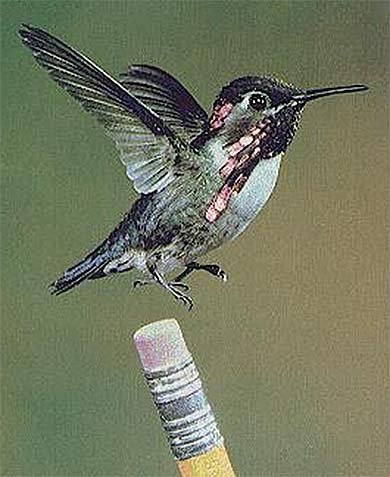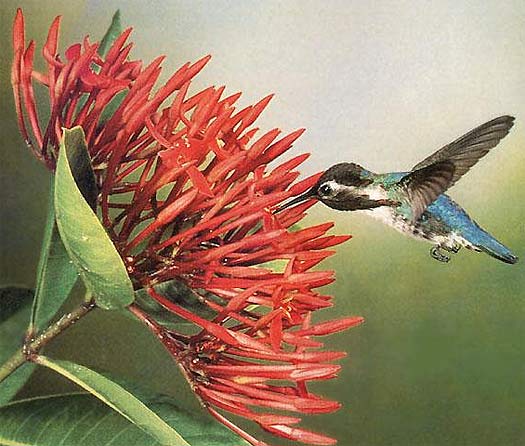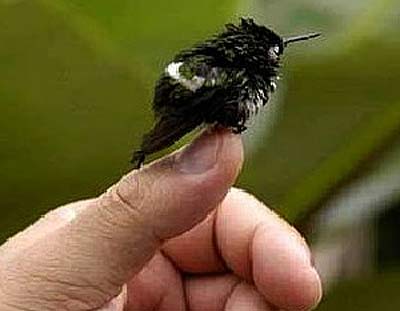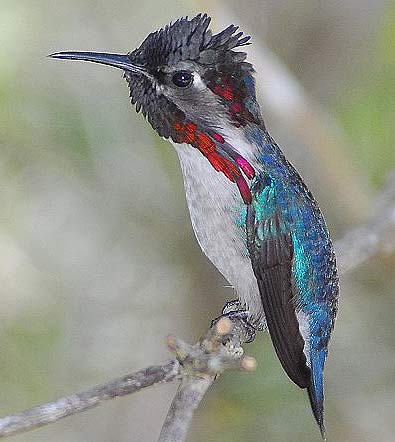| Bee hummingbird | |
|---|---|
 |
|
| Conservation status | |
| Scientific classification | |
| Kingdom: | Animalia |
| Phylum: | Chordata |
| Class: | Aves |
| Order: | Trochiliformes |
| Family: | Trochilidae |
| Genus: | Mellisuga |
| Species: | M. helenae |
| Binomial name | |
| Mellisuga helenae | |

The bee hummingbird is the smallest extant bird species on the face of the earth - extant being the opposite of extinct, that is to say, there are no living species of birds in the world smaller than the bee hummingbird. Exactly how small do you have to be to earn that distinction? No larger than 2 and a half inches long at most, with many birds no bigger than 2 inches total. With weight in a range between 0.056 and 0.067 ounces (1.6-1.9 g), these small birds are easily mistaken for insects, and are in fact not much bigger than the honey-making bugs for which they are named. They are also blessed with bright iridescent coloring of red, blue and green.


The IUCN, who monitors species populations world-wide has moved the bee hummingbird from its lowest warning level "least concerned" to the first elevated concern marker: "near threatened". Living mostly in Cuba and some small surrounding islands, these tiny birds beat their wings an astonishing 80 times per second! The speed at which the bee hummingbird flaps its wings is so fast that the motion is imperceptible to the human eye, and in flight the bee hummingbird is barely more than a blur to onlookers. And that rapid, busy, wing-motion is in fact attached to a busy body (much like a busy bee). Fact: the bee hummingbird is a critical part of their local ecosystem - one bee hummingbird may help pollinate up to 1,500 flowers in a typical day of feeding. Their slender, long bill is well-suited for nectar sipping. They feed mostly on nectar but may be enticed to nibble on an insect or spider too.

With tiny bodies comes tiny nests - a bee hummingbird's domicile is made predominantly from lichen, bark and even little scraps of cobweb. Occupying no more than an inch of space, a nesting hummingbird lays eggs the size of a green pea. These tiny nests can be found in the smallest of places, including literally on the ends of clothespins.
Description
The male has the green pileum and fiery red throat, iridescent gorget with elongated lateral plumes, bluish upper-parts, and the rest of the underparts mostly greyish white. The male is smaller than the female. The female is green above, whitish below with white tips to the outer tail feathers. Compared to other small hummingbirds, which often have a slender appearance, the Bee Hummingbird looks rounded and chunky.Female bee hummingbirds are bluish green with a pale gray underside. The tips of their tailfeathers have white spots. Breeding males have a reddish to pink head, chin, and throat. The female lays only two eggs at a time.
As the smallest bird in the world, it is no larger than a big insect and, as its name suggests, is scarcely larger than a bee. Like all hummingbirds, it is a swift, strong flier. It also can hover over one spot like a helicopter. The bee hummingbird beats its wings an estimated 80 times per second — so fast that the wings look like a blur to human eyes.
The brilliant, iridescent colors of the bee hummingbird's feathers make the bird seem like a tiny jewel. The iridescence is not always noticeable, but depends on the angle at which a person looks at the bird. The bird's slender, pointed bill is adapted for probing deep into flowers. The bee hummingbird feeds mainly on nectar, and an occasional insect or spider, by moving its tongue rapidly in and out of its mouth. In the process of feeding, the bird picks up pollen on its bill and head. When it flies from flower to flower, it transfers the pollen. In this way, it plays an important role in plant reproduction. In the space of one day the bee hummingbird may visit 1,500 flowers
Using bits of cobwebs, bark, and lichen, the female bee hummingbird builds a cup-shaped nest that is only about 2.5 cm (1 inch) in diameter. Nests have been built on single clothespins. She lines the nest with soft plant fibers. In this nest she lays her eggs, which are no bigger than peas. She alone incubates the eggs and raises the young.

Tidak ada komentar:
Posting Komentar